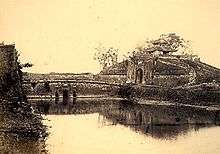Hanoi Citadel
| Central Sector of the Imperial Citadel of Thang Long - Hanoi | |
|---|---|
| Name as inscribed on the World Heritage List | |
 | |
| Type | Cultural |
| Criteria | ii, iii, iv |
| Reference | 1328 |
| UNESCO region | Asia-Pacific |
| Inscription history | |
| Inscription | 2010 (34th Session) |

The central old citadel of Hanoi was the former residence of Vietnamese monarchs dating back to Đại Việt, when the city was known as Thăng Long.
History
The Imperial Citadel of Thang Long dates to the Ly Dynasty (1010) and remained the seat of the Vietnamese court until 1810, when the Nguyen Dynasty chose to move the capital to Huế. The royal palaces and edifices were largely destroyed in the late 19th century. The few remaining structures within the royal compound are the Doan Mon gate, marking the southern entrance to the royal palace, the Flag Tower, the steps of Kinh Thiên Palace and the Hậu Lâu (Princess' Palace).
In the 20th century, the North Vietnamese military command under General Giap, had its headquarters within the Citadel, coded D67. A connecting underground tunnel allowed for emergency evacuation in case of an attack.
Construction work for the National Assembly building in 2003 uncovered extensive ruins the citadel dating back to the Thăng Long era. Many of the historical relics were removed to the Vietnamese History Museum. The archeological finds has halted the construction of the National Assembly building on the site, pending additional excavations.
As of 2000, some of the old French barracks and buildings were demolished to make room for a new museum within the citadel.
In 2010 the Citadel was registered with UNESCO World Heritage List as "The Central Sector of the Imperial Citadel of Thang Long - Hanoi".[1]
References
Literature
- Vietnam Institute of Archaeology (ed.). Thang Long Imperial Citadel. (2006). Culture and Information Publishing House. Hanoi.
External links
 Media related to Citadel of Hanoi at Wikimedia Commons
Media related to Citadel of Hanoi at Wikimedia Commons- IHT | Ruins of royal complex of Thang Long are excavated in Hanoi Article from October 17, 2007, accessed December 31, 2008
- Việt Nam News | Historic Thang Long Citadel explored Article from December 21, 2008, accessed December 31, 2008